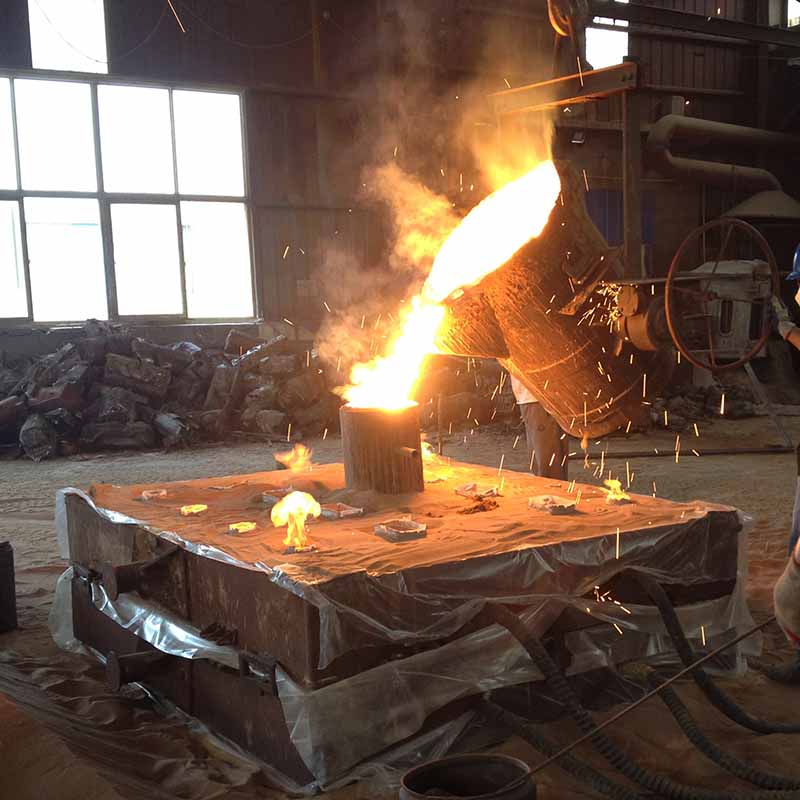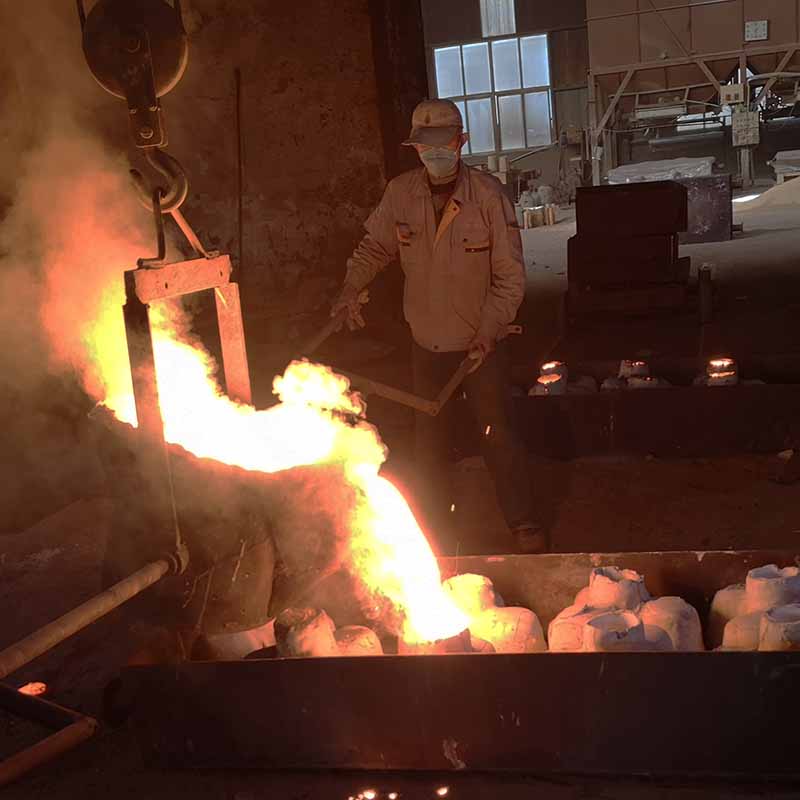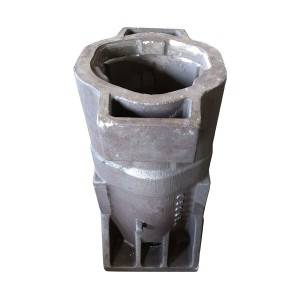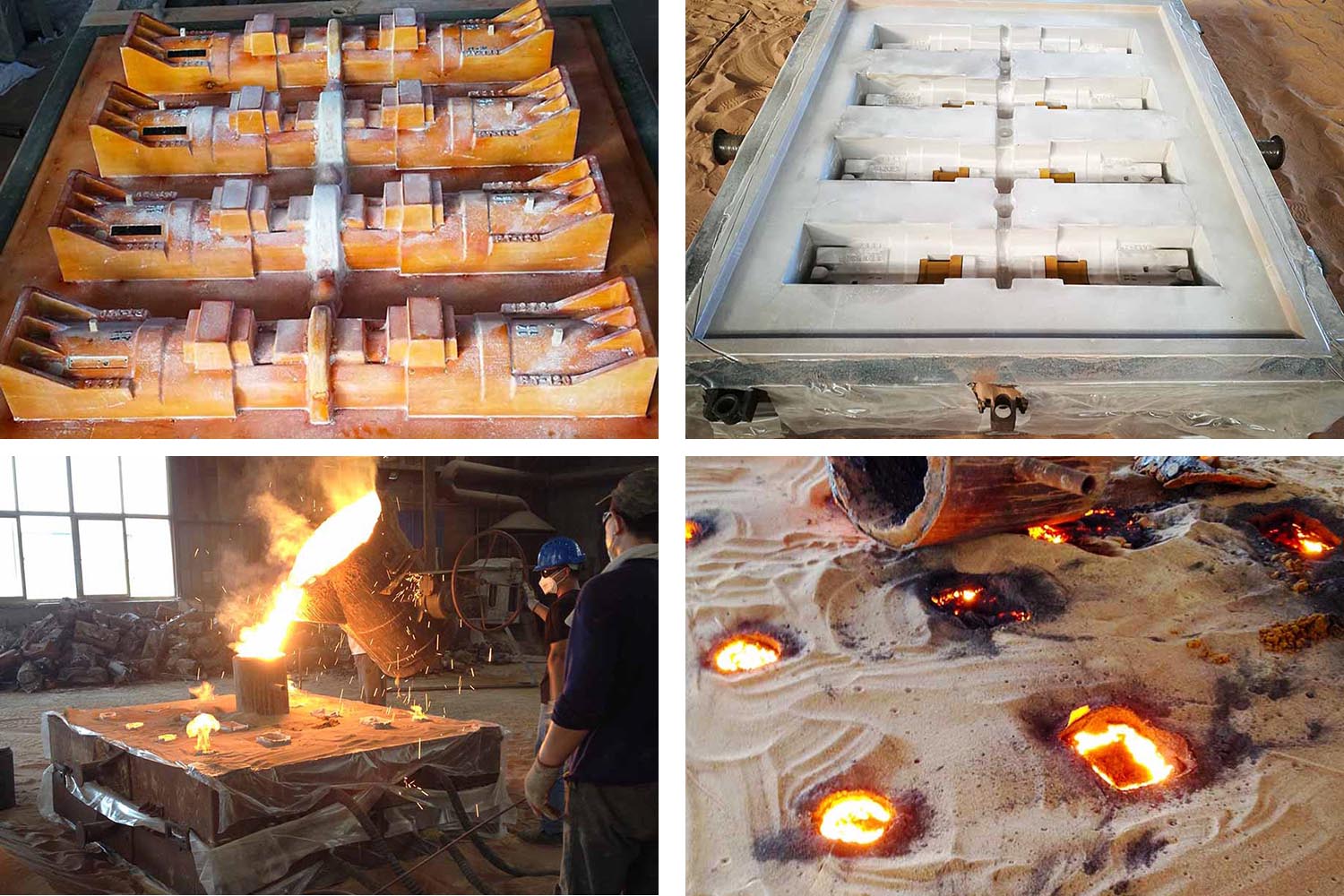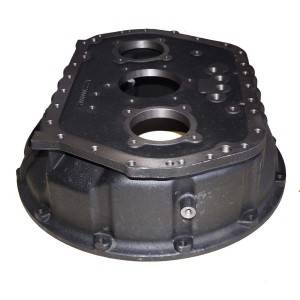China OEM custom vacuum casting spare parts for railroad freight cars of Cr-Mo alloy steel with heat treatment, surface treatment and CNC machining service.
Vacuum Casting is also called Negative Pressure Sealed Casting, Reduced Pressure Casting or V Process Casting. Vacuum pressure casting requires the use of air extraction equipment to extract the air inside the casting mold, and then use the pressure difference between the inside and outside of the mold to cover the heated plastic film on the pattern and template. The casting mold will become strong enough to withstand the molten metal during casting. After obtaining the vacuum mold, fill the sand box with dry sand without binder, and then seal the top surface of the sand mold with the plastic film, followed by vacuum to make the sand firm and tight. After that, remove the mold, put the sand cores, close the mold to make everthing ready for pouring. Finally, the casting is obtained after the molten metal is cooled and solidified.
| Lost Foam Casting vs Vacuum Casting | ||
| Item | Lost Foam Casting | Vacuum Casting |
| Suitable Castings | Small and medium-sized castings with complex cavities, such as engine block, engine cover | Medium and large castings with few or no cavities, such as cast iron counterweights, cast steel axle housings |
| Patterns and Plates | Foam patterns made by moldings | Template with suction box |
| Sand Box | Bottom or five sides exhaust | Four sides exhaust or with exhaust pipe |
| Plastic Film | The top cover is sealed by plastic films | All sides of both halves of sand box are sealed by plastic films |
| Coating Materials | Water-based paint with thick coating | Alcohol-based paint with thin coating |
| Molding Sand | Coarse dry sand | Fine dry sand |
| Vibration Molding | 3 D Vibration | Vertical or Horizontal Vibration |
| Pouring | Negative Pouring | Negative Pouring |
| Sand Process | Relieve negative pressure, turn over the box to drop sand, and the sand is then reused | Relieve negative pressure, then the dry sand falls into the screen, and the sand is recycled |
What Are the Advantages of Vacuum Casting?
1) The vacuum castings have high dimensional accuracy, clear outline and smooth surface.
2) There are no binders, water and additives in the molding sand, which makes the sand processing simple.
3) It is simple to clean the vacuum castings. Less harmful gases are generated during the casting process.
4) The vacuum castings could be used at a wide range of industries. It can be used for single-piece small batch production as well as mass production, especially large and medium-sized castings and thin-walled castings are more suitable for vacuum casting.
What Metals and Alloys Could Be Cast by Vacuum Casting?
• Gray Cast Iron, Ductile Cast Iron
• Carbon Steel: Low carbon, medium carbon and high carbon steel
• Cast Steel Alloys: Low alloy steel, high alloy steel, special alloy steel
• Aluminium and their alloys
• Brass & Copper.
Cast steel refers to the steel used for the manufacture of steel castings. Cast steel should be used when the strength of the casting is relatively high and the use of cast iron cannot meet the requirements. However, the fluidity of molten steel of cast steel is not as good as that of cast iron, so the thickness of the pouring structure should not be too small and the shape should not be too complicated. When the silicon content is controlled at the upper limit, the fluidity of molten steel can be improved. Cast steel can be divided into cast alloy steel and cast carbon steel according to its chemical composition, and can also be divided into cast tool steel, cast special steel, engineering and structural casting and cast alloy steel according to its characteristics.
Cast alloy steel can be divided into cast low alloy steel (the total alloy elements are less than or equal to 5%), cast alloy steel (the total alloy elements are 5% to 10%) and cast high alloy steel (the total alloy elements are greater than or equal 10%).
| Equivalent Grade of Cast Alloy Steel from Different Markets | |||||||
| Categories | AISI | W-stoff | DIN | BS | SS | AFNOR | JIS |
| Low Alloy Steel | 9255 | 1.0904 | 55 Si 7 | 250 A 53 | 2090 | 55 S 7 | - |
| 1335 | 1.1167 | 36 Mn 5 | 150 M 36 | 2120 | 40 M 5 | SMn 438(H) | |
| 1330 | 1.1170 | 28 Mn 6 | 150 M 28 | - | 20 M 5 | SCMn1 | |
| P4 | 1.2341 | X6 CrMo 4 | - | - | - | - | |
| 52100 | 1.3505 | 100 Cr 6 | 534 A 99 | 2258 | 100 C 6 | SUJ 2 | |
| A204A | 1.5415 | 15 Mo 3 | 1501 240 | 2912 | 15 D 3 | STBA 12 | |
| 8620 | 1.6523 | 21 NiCrMo 2 | 805 M 20 | 2506 | 20 NCD 2 | SNCM 220(H) | |
| 8740 | 1.6546 | 40NiCrMo22 | 311-Type 7 | - | 40 NCD 2 | SNCM 240 | |
| - | 1.6587 | 17CrNiMo6 | 820 A 16 | - | 18 NCD 6 | - | |
| 5132 | 1.7033 | 34 Cr 4 | 530 A 32 | - | 32 C 4 | SCr430(H) | |
| 5140 | 1.7035 | 41 Cr 4 | 530 A 40 | - | 42 C 2 | SCr 440 (H) | |
| 5140 | 1.7035 | 41 Cr 4 | 530 A 40 | - | 42 C 2 | SCr 440 (H) | |
| 5140 | 1.7045 | 42 Cr 4 | 530 A 40 | 2245 | 42 C 4 TS | SCr 440 | |
| 5115 | 1.7131 | 16 MnCr 5 | (527 M 20) | 2511 | 16 MC 5 | - | |
| 5155 | 1.7176 | 55 Cr 3 | 527 A 60 | 2253 | 55 C 3 | SUP 9(A) | |
| 4130 | 1.7218 | 25 CrMo 4 | 1717CDS 110 | 2225 | 25 CD 4 | SCM 420 / SCM430 | |
| 4135 (4137) | 1.7220 | 35 CrMo 4 | 708 A 37 | 2234 | 35 CD 4 | SCM 432 | |
| 4142 | 1.7223 | 41 CrMo 4 | 708 M 40 | 2244 | 42 CD 4 TS | SCM 440 | |
| 4140 | 1.7225 | 42 CrMo 4 | 708 M 40 | 2244 | 40 CD 4 | SCM 440 | |
| 4137 | 1.7225 | 42 CrMo 4 | 708 M 40 | 2244 | 42 CD 4 | SCM 440 | |
| A387 12-2 | 1.7337 | 16 CrMo 4 4 | 1501 620 | 2216 | 15 CD 4.5 | - | |
| - | 1.7361 | 32CrMo12 | 722 M 24 | 2240 | 30 CD 12 | - | |
| A182 F-22 | 1.7380 | 10 CrMo9 10 | 1501 622 | 2218 | 12 CD 9, 10 | - | |
| 6150 | 1.8159 | 50 CrV 4 | 735 A 50 | 2230 | 50 CV 4 | SUP 10 | |
| - | 1.8515 | 31 CrMo 12 | 722 M 24 | 2240 | 30 CD 12 | - | |
| - | - | - | - | - | - | - | |
| Medium Alloy Steel | W1 | 1.1545 | C105W1 | BW1A | 1880 | Y 105 | SK 3 |
| L3 | 1.2067 | 100Cr6 | BL 3 | (2140) | Y 100 C 6 | - | |
| L2 | 1.2210 | 115 CrV 3 | - | - | - | - | |
| P20 + S | 1.2312 | 40 CrMnMoS 8 6 | - | - | 40 CMD 8 +S | - | |
| - | 1.2419 | 105WCr6 | - | 2140 | 105W C 13 | SKS 31 | |
| O1 | 1.2510 | 100 MnCrW 4 | BO1 | - | 90MnWCrV5 | (SK53) | |
| S1 | 1.2542 | 45 WCrV 7 | BS1 | 2710 | 55W20 | - | |
| 4340 | 1.6582 | 34 CrNiMo 6 | 817 M 40 | 2541 | 35 NCD 6 | SNCM 447 | |
| 5120 | 1.7147 | 20 MnCr 5 | - | - | 20 MC 5 | - | |
| - | - | - | - | - | - | - | |
| Tool and High Alloy Steel | D3 | 1.2080 | X210 Cr 12 | BD3 | 2710 | Z200 C 12 | SKD 1 |
| P20 | 1.2311 | 40 CrMnMo 7 | - | - | 40 CMD 8 | - | |
| H13 | 1.2344 | X40CrMoV 5 1 | BH13 | 2242 | Z 40 CDV 5 | SKD 61 | |
| A2 | 1.2363 | X100 CrMoV 5 1 | BA2 | 2260 | Z 100 CDV 5 | SKD 12 | |
| D2 | 1.2379 | X155 CrMoV 12 1 | BD2 | 2310 | Z 160 CDV 12 | SKD11 | |
| D4 (D6) | 1.2436 | X210 CrW 12 | BD6 | 2312 | Z 200 CD 12 | SKD 2 | |
| H21 | 1.2581 | X30WCrV9 3 | BH21 | - | Z 30 WCV 9 | SKD5 | |
| L6 | 1.2713 | 55NiCrMoV 6 | - | - | 55 NCDV 7 | SKT4 | |
| M 35 | 1.3243 | S6/5/2/5 | BM 35 | 2723 | 6-5-2-5 | SKH 55 | |
| M 2 | 1.3343 | S6/5/2 | BM2 | 2722 | Z 85 WDCV | SKH 51 | |
| M 7 | 1.3348 | S2/9/2 | - | 2782 | 2 9 2 | - | |
| HW 3 | 1.4718 | X45CrSi 9 3 | 401 S 45 | - | Z 45 CS 9 | SUH1 | |
| - | 1.7321 | 20 MoCr 4 | - | 2625 | - | - | |
| High Tensile Strength Steel | A128 (A) | 1.3401 | G-X120 Mn 12 | BW10 | 2183 | Z 120 M 12 | SCMnH 1 |
